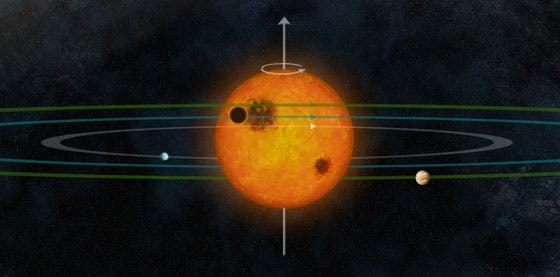
Researchers at MIT, the University of California at Santa Cruz and other institutions have come across the first exoplanetary system, whose planets exhibit a regularly aligned orbit, after analyzing data from NASA’s Kepler space telescope. So far, other discovered exoplanetary systems had planets, particularly hot-Jupiters, which presented far more eccentric orbits.
Our solar system is comprised of eight planets, each orbiting their own regular lane and always on the same plane, in contrast to the rest of the other planetary systems discovered thus far. Finally, data from Kepler, an instrument that monitors 150,000 stars for signs of distant planets, has revealed a solar system very much similar to our own, 10,000 light years away and at the center of which lies Kepler-30, a star as bright and massive as the sun. The star has a vertical axis and has three planets which orbit in the same plane.
“In our solar system, the trajectory of the planets is parallel to the rotation of the sun, which shows they probably formed from a spinning disc,” says MIT graduate student Roberto Sanchis-Ojeda. “In this system, we show that the same thing happens.”
Some scientists worried that our solar system’s orbital structure might be extremely rare, if not unique – a fluke of nature. This recent find proves that something one of a kind in the Universe comes at a distant possibility, a cosmic one.
“It’s telling me that the solar system isn’t some fluke,” says Josh Winn, an associate professor of physics at MIT and a co-author on the paper. “The fact that the sun’s rotation is lined up with the planets’ orbits, that’s probably not some freak coincidence.”
The finding seems to support a recent theory which discuss how hot-Jupiters form – giant bodies named after their extremely close proximity to their white-hot stars, completing an orbit in mere hours or days. Kepler-30 provides evidence that only hot Jupiter systems are misaligned, formed as a result of planetary scattering.
“We’ve been hungry for one like this, where it’s not exactly like the solar system, but at least it’s more normal, where the planets and the star are aligned with each other,” Winn says. “It’s the first case where we can say that, besides the solar system.”
Planetary orbits correlated with life?
There could be implications for the study of how life evolved in the universe, as in order to have a stable climate suitable for life, a planet needs to be in a stable orbit.
“In order to understand how common life is in the universe, ultimately we will need to understand how common stable planetary systems are,” Lloyd says. “We may find clues in extrasolar planetary systems to help understand the puzzles of the solar system, and vice versa.”
Findings were published today in the journal Nature.
source: MIT newsroom
Was this helpful?



